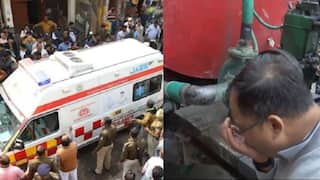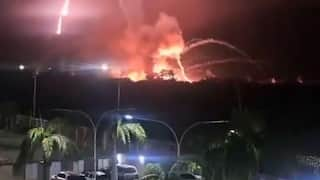Modi Govt Serious About LAC, Infra Push At China Border 'Much Stronger' Than Under Previous Govts: Jaishankar
Jaishankar said quality of infrastructure at border areas is essential to effectiveness of troops deployment and that's why Modi government is 'serious' on border infrastructure development.

New Delhi: The Narendra Modi government is “serious” about developing the border areas, especially those bordering China, for effective deployment of forces, External Affairs Minister S Jaishankar said Monday. He said the budget earmarked for developing high quality roads and bridges along the Line of Actual Control (LAC), the de facto boundary with China, has witnessed a surge of 400 percent in 2022 compared to 2008.
“The big effort in respect to China has been to push our border infrastructure much stronger, than they have been (under previous governments),” Jaishankar said, adding that national security is the “predominant factor” when it comes to the LAC.
“There has been an increase of 400 per cent in the budget (since 2008) in developing the infrastructure at the China border … Aim is to develop quality infrastructure for our armed forces…Because the quality of infrastructure is so essential to the effectiveness of deployment and effectiveness of deployment is a sign of seriousness of policy," he said.
Jaishankar said nearly 6,800 km of road has been built along the China border since 2014. This is in contrast to the 3,600 km developed between 2008 and 2014.
“Infrastructure and connectivity along the China border is primarily driven by security considerations. In the past, before 2014, there was neglect of border infrastructure that had a negative impact on our ability to deploy troops," Jaishankar underscored.
“We have built from very difficult roads to the highest motorable roads… When it comes to national security, the quality of infrastructure is so essential to the effectiveness of deployment, and effectiveness of deployment is a sign of seriousness of policy,” the external affairs minister said.
Taking a jibe at the opposition, Jaishankar said: “It is not how loudly you speak. It is what you have done on the ground… A government or political party that is serious will actually deliver on the border infrastructure. Those who neglect border infrastructure cannot then say yes we are serious about it.”
Critical Roads Built Along LAC To Counter China
Jaishankar said it was under the Modi government that India built one of the world’s highest motorable roads near the LAC, which is at Umling La, a mountainous pass near the Demchok area in Ladakh. The road construction was completed in 2021.
“Today we find that most of the critical roads which were closed because of weather conditions, because the roads are now better made, there is more tunnelling, the quality of roads is very different, so the closure time of the passes has actually shrunk. This has significant cost implications,” he said.
Jaishankar also said there are 16 passes in total that are key to the Kashmir and Ladakh sectors of the LAC. “These (passes) today are in much more operational condition than they were before.”
The minister also pointed out that the Border Roads Organisation (BRO) is building 70 new roads on the western sector of the LAC, and through Arunachal Pradesh the Ministry of Road Transport and Highways is working out a plan for intra-valley connection. An 800-km long road is being built across the length of the border that comes in Arunachal Pradesh area. This road is being built at a cost of Rs. 30,000 crore.
“These developments are going to reflect our response to our national security challenges,” Jaishankar said, adding that roads are also being built from Chushul to Demchok. The Chushul-Demchok area is of huge strategic importance for India facing Chinese aggression.
Chushul is located south of Pangong Tso, which China threatens to use for launching an offensive against India. Demchok is the last inhabited area along the LAC.
Jaishankar also pointed out that a frontier highway of about 1,800 km length is being made in Arunachal Pradesh that would facilitate inter-valley connectivity. This would have a significant impact on both internal and border connectivity.
“The increased budgeting, faster construction, newer technology and speedier clearances reflect the Modi Government’s commitment to secure our borders,” said Jaishankar.
Bridges along the border are also being built at a faster pace, said the minister, adding that their construction has gone up three times.
“Right now, on an average, in the last three years, we have dug up five tunnels and seven more are under planning. Lot of these are high altitude, long tunnels are being built. These had major implications,” he said.
The Atal tunnel, which is 9.02 km long, has provided all-weather connectivity to the Lahaul-Spiti valley that used to be a “major cause of concern” for India, Jaishankar highlighted. This has also helped India gain a certain degree of strategic heft on China.
Jaishankar also shed light on the fact that the government is building a tunnel at Sela Pass in Tawang area of Arunachal Pradesh. The importance of Sela Pass has its significance since the 1962 India-China war.
Construction On Myanmar Border Facing Difficulties
For the first time since the coup took place in Myanmar in February 2021, the government admitted to facing “difficulties” and “security challenges” due to the situation unleashed by the junta there.
Construction of the India-Myanmar-Thailand trilateral highway is facing “big challenges”, according to Jaishankar. He said India has been able to build about half of the 115 kms of the trilateral highway and 69 bridges.
“But we are finding it difficult to do due to security challenges,” he said, adding, “We today have to engage with the authorities in Myanmar and these are big concerns.”
“Our overall border infrastructure in the northeast is impacted today by what is happening in Myanmar,” he said.
Related Video
India@2047 Summit: Modi Calls for Innovation, Reforms, and National Resolve






































